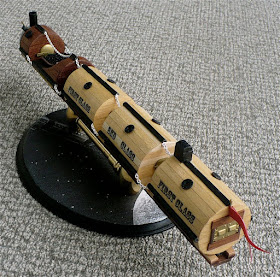




Here are some images of my scratch built model of the Moon Train from the Jules Verne novel "From the Earth to the Moon". Based off of the 1865 etching.
From Wikipedia"
From the Earth to the Moon (French: De la Terre à la Lune, 1865) is a humorous science fantasy novel by Jules Verne and is one of the earliest entries in that genre. It tells the story of the president of a post-American Civil War gun club in Baltimore, his rival, a Philadelphia maker of armor, and a Frenchman, who build an enormous sky-facing Columbiad space gun and launch themselves in a projectile/spaceship from it to a Moon landing.
The story is also notable in that Verne attempted to do some rough calculations as to the requirements for the cannon and, considering the comparative lack of any data on the subject at the time, some of his figures are surprisingly close to reality. However, his scenario turned out to be impractical for safe manned space travel since a much longer muzzle would have been required to reach escape velocity while limiting acceleration to survivable limits for the passengers.
Influence on popular culture
The novel was adapted as the opera Le voyage dans la lune in 1875, with music by Jacques Offenbach.
In H. G. Wells' 1901 The First Men in the Moon (also relating to the first voyagers to the Moon) the protagonist, Mr. Bedford, mentions Verne's novel to his companion, Professor Cavor, who replies (in a possible dig at Verne) that he does not know what Bedford is referring to. Verne returned the dig later when he pointed out he used guncotton to send his men to the moon, and one could see it any day. "Can Mr. Wells show me some "cavourite"?", he asked archly.
The novel (along with Wells' The First Men in the Moon) inspired the first science fiction film, A Trip to the Moon, made in 1902 by Georges Méliès. In 1958, another film adaptation of this story was released, titled From the Earth to the Moon. It was one of the last films made under the RKO Pictures banner. The story also became the basis for the very loose adaptation Jules Verne's Rocket to the Moon (1967), a caper-style British comedy starring Burl Ives and Terry-Thomas. The 1961 Czechoslovak film The Fabulous Baron Munchausen combines characters and plot elements from the Verne novel with those of the stories of Baron Münchhausen and Cyrano de Bergerac.
The novel and its sequel were the inspiration for the computer game Voyage: Inspired by Jules Verne.
In 1889 Verne wrote a second sequel to the novel, The Purchase of the North Pole, which has the gun club members (led by J. T. Maston) plan to use the "Columbiad" to alter the tilt of the earth to enable the mineral wealth of the Arctic region to be put within reach of exploitation.
Among its other homages to classic science fiction, an issue of Planetary involved the Planetary group finding that the Gun Club had been successful in launching the projectile, but that a miscalculation led to a slowly decaying orbit over the decades with the astronauts long dead from lack of air and food.
Barbicane appears in Kevin J. Anderson's novel Captain Nemo: The Fantastic History of a Dark Genius as an Ottoman official whose chief rival, Robur, designs a number of innovative weapons to counteract him, including an attempt to launch a three-man mission to the Moon.
During their return journey from the moon, the crew of Apollo 11 made reference to Jules Verne's book during a TV broadcast on July 23. The mission's commander, astronaut Neil Armstrong, said, "A hundred years ago, Jules Verne wrote a book about a voyage to the Moon. His spaceship, Columbia [sic], took off from Florida and landed in the Pacific Ocean after completing a trip to the Moon. It seems appropriate to us to share with you some of the reflections of the crew as the modern-day Columbia completes its rendezvous with the planet Earth and the same Pacific Ocean tomorrow."
In Back to the Future Part III, Clara Clayton asks Emmett Brown if he believes mankind will ever "travel to the moon the way we travel across the country on trains." Being from the future Doc already knows that doesn't happen for another 84 years, but he affirms they will while quoting a passage from From the Earth to the Moon. Clara calls him out on this, and it's from this encounter that the pair discovers their mutual love of Jules Verne novels.

Wow! this is an extremely cool build, looks great! Nice piece for your collection.
ReplyDeleteThanks Ludo - I've been doing a series of spaceships from science fiction novels.
ReplyDeleteVery cool! I'm enjoying the sci-fi series you're working on.
ReplyDeleteThanks Hanny - My next in the novel series will probably be the Torch ship from Heinlein's "Time for the Stars".
ReplyDelete